I am going to be devoting my blog posts this month to a central idea: bodies whose sensory capacities have been compromised, and how literatures can engage, represent, or transform these states of being.
What kind of writing is produced by these compromised bodies? And how do these bodies read texts?
The list of the ways in which our bodies have been compromised is too long. However, as a starting point…
I am thinking of how the city can be beautiful one minute then ugly the next.
I am thinking of how I can barely smell or taste. My sensitivity to noise pollution.
I am thinking about how our bodies eat from poor soil (and how we’ve come to accept poor-quality, industrial, edible food-like substances as actual food; also, how our diet consists largely of cheap, refined sugars—food fed to laborers so that they will keep working).
I think of bodies that are bad at touching and being touched.
I am thinking of systems of ideology and propaganda that cause people to doubt their actual sensory perceptions or engagements with the real.
I think of bodies with terrible jobs or no jobs or terrible homes or no homes.
I am thinking of bodies under surveillance and fashionable bodies.
I am thinking of bodies that walk through space like divining rods.
And bodies that are trying to define themselves outside of, and beyond, the default of trauma.
I am thinking that we don’t even know which senses we possess.
I am thinking we are ill-equipped to evaluate and measure our senses to begin with.
There is an innovative reading series here in Los Angeles called ENTER>text, co-created by Henry Hoke and Marco Franco Di Domenico. Henry Hoke calls the series a “living literary journal.” The series attempts to overturn the format of the traditional literary reading by giving the audience-participants living encounters with texts. Performances are immersive, like walking three-dimensionally inside books. The alphabet becomes atmospheric, lucid, tactile. The series often takes place in buildings or homes with many rooms. The audience will roam from room to room to encounter each performance. Some performances take place in secret, and some in seclusion. For example, during a performance from this past July’s event, my friend Harold was told he was the next messiah, whereby he was ushered underground, into a dimly lit backroom, wherein he was then given the blessing of a priestessprostitute who was dressed in sheer black clothes and wearing a lot of makeup; and then he was told that he had to either drink absinthe or orange juice. Of course, he was shaken. A lot of us might be shaken if we had to live inside our favorite books.
Some might call ENTER>text an experiment in relational aesthetics. I circle back to my original premise: how does the compromised body relate? Relate, of course, to itself, to others, to the living world, or to the relics and remnants of the past? And, also, when should this body leave the world alone? Can it leave the world alone?
These were questions that (the aforementioned) Harold Abramowitz, Andrea Quaid, and I were asking while creating a performance for ENTER>text. I often write or perform as part of UNFO (The Unauthorized Narrative Freedom Organization). UNFO is an ever-changing body—in other words, any group of people can come together and call itself UNFO. (You, too, can be UNFO). This time, UNFO was me, Andrea, and Harold. We attempted to create a performance in which we would leave the world entirely alone. We called it "UNFO Leaves the World Alone."
We decided to create a text-based performance in which the following would happen: A random number of people would be brought into a room. Then we would say something like the following: “Hello. We are UNFO (the Unauthorized Narrative Freedom Organization), and for the next five-seven minutes, you are the world.” We would offer them a set of index cards, of which they could choose three. On each card would be a set of instructions. We would tell the world, “You may execute these instructions in any manner you see fit. This includes the option of not executing any of these instructions at all. Good luck. We will come back to get you soon.” Then we would walk away, close the door behind us, and leave the world alone.
The room would also have some basic materials like blank notebooks, lined yellow paper, pens, pencils, tape, and one pair of scissors.
The instructions on each index card were appropriated from old Fluxus instructions (we thought appropriation was a better strategy for leaving the world alone than generating new material) from the Fluxus Performance Workbook, which included work from artists such as Don Boyd, Ben Vautier, and Eric Anderson. Each index card held one of the following instructions:
Do and /or don’t do something universally.
Write a sentence that cannot be read by more than one person at the same time.
Writers use mirrors to show the reader to itself.
The room is divided into two teams. They draw lots for one violin. The winning team plays the violin while the other team tries to gain possession of it.
1. Change places.
2. Talk together.
3. Give something to your neighbor.The writers are invited to dance a tango.
1. before hearing
2. hearing
3. after hearingMake a work with the fewest elements possible.
Find a sheep. Watch it 30 minutes.
Find a wolf. Watch it 30 minutes.
Arrange and discover an event.
Score and then realize it.Do not prepare for the writing and even try to forget that in a short time you will be writing. When the time of writing comes, simply do something appropriate.
Writers inconspicuously attach spring-type clothes pins to various objects in the street.
Pass by a tree or let some object pass by a tree, but each time differently.
Become invisible
a) by hiding
b) by divesting yourself of all distinguishing marks
c) by going away
d) by sinking through the floor
e) by becoming someone else
f) by concentrating so hard on some object or idea that you cease to be aware of your physical appearance
g) by distracting everybody else from your physical presence
h) by ceasing to existCook soup for the entire room. Serve it.
Brush your teeth using a different toothbrush for each tooth.
In a closed room pass over 5 minutes in silence. (You may do anything but speak.)
Write a word or words in a notebook and place it somewhere. Please tell someone the word and the place, which will be edited on the world map.
Throw things that are difficult to throw because of their light weight.
Do not abide by your decision.
Copyright your genetic code.
A love letter on a bicycle carrier.
When you walk into a forest, don’t forget to knock.
Take a book and a pen. Sit in the woods for 30 minutes, watching and listening. Write of what you see and feel and hear.
Sit down and think about the people all over the world who may be writing this.
Fill all the drawers of a chest to the brim with oranges and depart for another part of the world.
Some yellow seats in all parks, squares and subway trains, where people who want to be talked to can sit down. Do this in every city all over the world.
The room where the performance took place was inside a small guesthouse. It had a bathroom, a sink, a bed, some cupboards, a desk, a chair, and some art on the walls. It had large sliding-glass doors so we could actually look in and view the world if we wanted to take a glance.
Throughout the course of the night, several worlds were built and then replaced by new worlds. Each world existed as the world for about five to seven minutes. The smallest world consisted of one person and the largest of about twelve people.
Here is a sliver of what happened:
Some of the instructions were executed beautifully and surprisingly (I wish I had a photo of the world that created an answer for “Write a sentence that cannot be read by more than one person at the same time”—they made a kaleidoscopic viewfinder out of lined yellow paper with a beautiful sentence written at the end of the tube.).
There was solidarity and ingenuity:
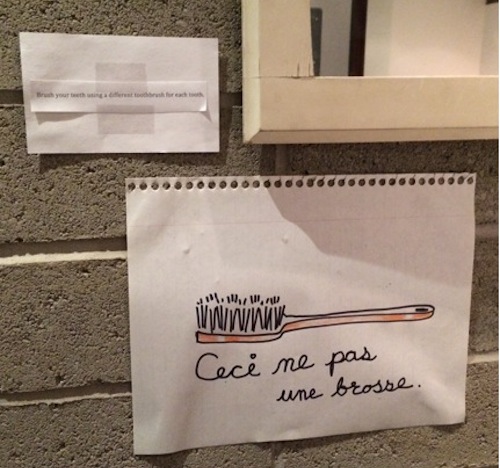
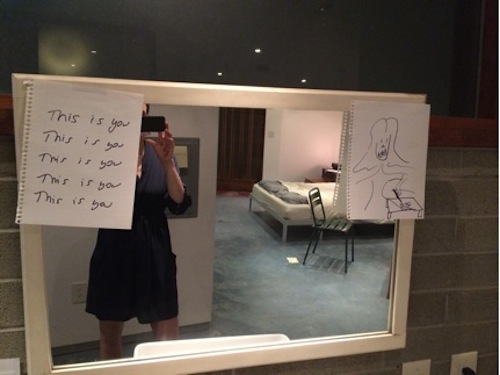
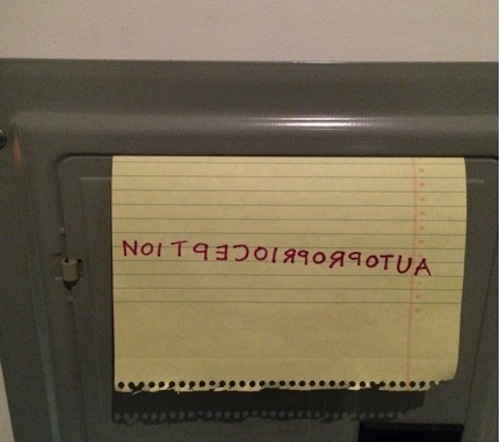
The very first world of the night only consisted of two people who were (we think) strangers to each other. They made the most beautiful, lasting monuments—imprinting the future worlds to come. Notice, in the right-hand corner of the desk, the standing starflower, sun-burst shaped sculptural structures, towering above the rest. Those were the first creations of the night.
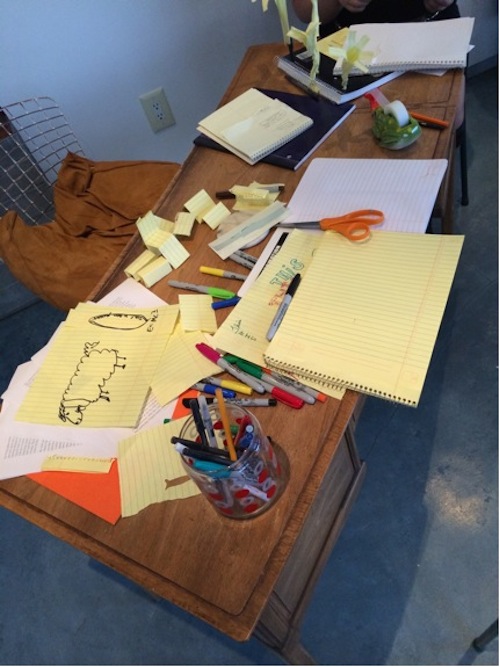
As worlds were created, ended, and then replaced by new worlds, a fair amount of cultural detritus started to accumulate. One world’s work became layered on another’s, until some pieces were buried forever.
Also, some groups started to leave behind their trash.
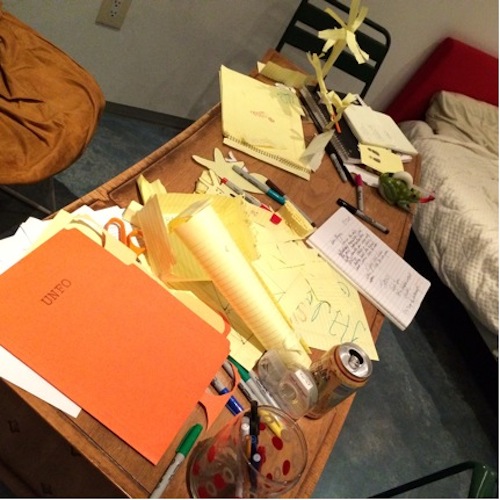
Some groups began to trample and take over the space of the guest house. This statue of a squirrel was tucked away into an obscure corner of the room—yet it was discovered and altered.
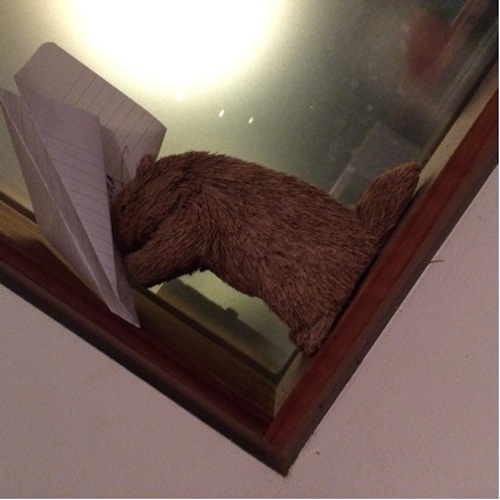
There was an actual artist-in-residence living in the guesthouse, whom none of us knew. Some of his stuff was pulled out of drawers. Here is a stack of his books that was removed from a private cabinet and placed out in the open:
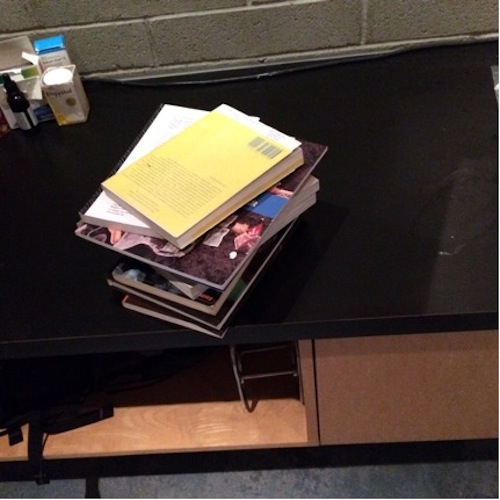
The art on the walls was defiled:
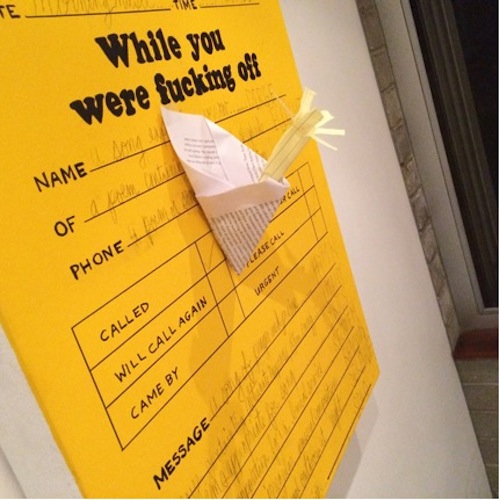
The man’s bed was also lain in, sometimes by one or two people, sometimes by entire groups:
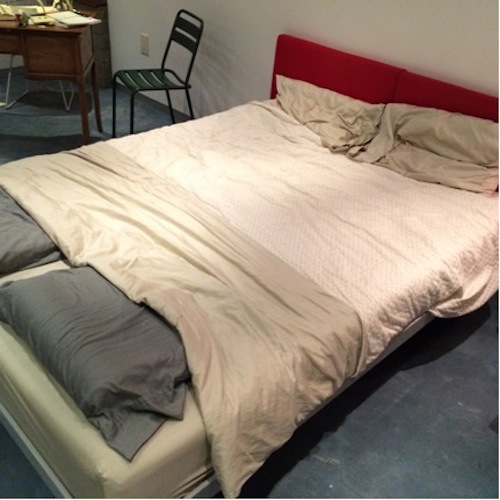
Drawers were pulled open and text scattered about the room (for some reason, the piece of paper on top of the alarm clock kept getting moved around the room by various successive worlds):
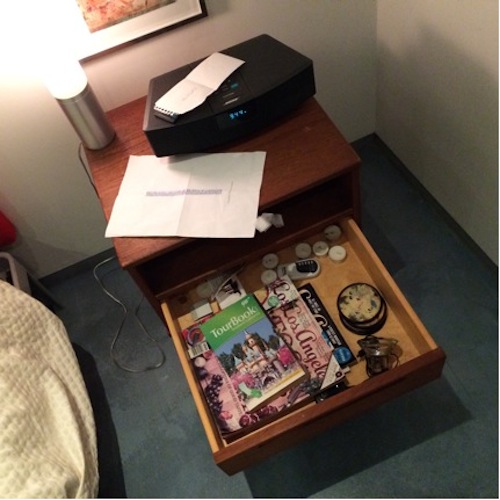
Each world also had its own unique signature. Some groups got wild (we heard howling and banging). Some divided in half, and others worked in concert. There were anarchists and dictatorships, to be sure. Some sang, “We are the world.” Some worlds labored in benevolent silence, like old-world gods working at illuminated manuscripts. At one point, we did glance through the sliding glass doors to see the world dancing a tango.
Then, at another point during the night, one particular world arrived that decided to destroy all the works of the previous worlds—all, except for a couple of relics (notice the first world’s monuments were allowed to remain; all the other pieces were shoved into the desk):
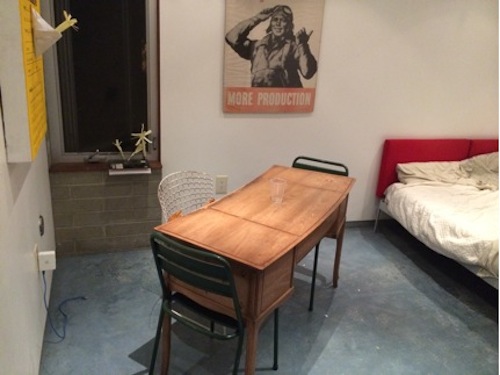
However, the world did not end there. Other worlds came. They opened the desk. They resuscitated and built-on some of the previous worlds’ works. Sometimes there were surely invisible hands at work.
There are so many worlds. And the world will never end.
Writer and teacher Amanda Ackerman earned an MFA at the California Institute of the Arts. Her work blurs...
Read Full Biography

